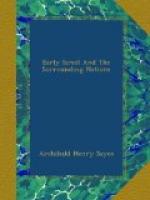The cities were busy centres of trade. Commercial intercourse was carried on with all parts of the known world. Wheat was exported in large quantities, as well as dates and date-wine. The staple of Babylonian industry, however, was the manufacture of cloths and carpets. Vast flocks of sheep were kept on the western bank of the Euphrates, and placed under the charge of Bedawin from Arabia. Their wool was made into curtains and rugs, and dyed or embroidered fabrics of various kinds. Even Belshazzar, the heir-apparent of Nabonidos, did not disdain to be a wool-merchant, and we find him lending twenty manehs, the proceeds of the sale of some of it, and taking as security for the repayment of the debt certain house-property in Babylon. It was “a goodly Babylonish garment,” secreted by Achan from among the spoil of Jericho, that brought destruction upon himself and his family.
Money-lending naturally occupied a prominent place in the transaction of business. The ordinary rate of interest was 20 per cent, paid in monthly instalments; in the time of Nebuchadrezzar, however, it tended to be lower, and we find loans made at 13-1/2 per cent. The penalty was severe if the capital were not repaid at the specified date. The payment was occasionally in kind, but money was the usual medium of exchange. It consisted of rings or tongue-like bars of gold, silver, and copper, representing manehs and shekels. The maneh was divided into sixty shekels, and the standard used in later Babylonia had been fixed by Dungi, king of Ur. One of the standard maneh-weights of stone, from the mint of Nebuchadrezzar, is now in the British Museum. In the time of the Second Babylonian empire stamped or coined money was introduced, as well as pieces of five or more shekels. This was the period when the great banking firm of Egibi flourished, which anticipated the Rothschilds in making loans to the State.
The Babylonian cemetery adjoined the cities of the living, and was laid out in imitation of the latter. The tombs were built of crude bricks, and were separated from one another by streets, through which flowed streams of “living water.” Gardens were planted by the side of some of the tombs, which resembled the houses of the living, and in front of which offerings were made to the dead. After a burial, brushwood was heaped round the walls of the tomb and set on fire, partially cremating the body and the objects that were interred with it within. Sanitary reasons made this partial cremation necessary, while want of space in the populous plain of Babylonia caused the brick tombs to be built, like the houses of the towns, one on the top of the other.




